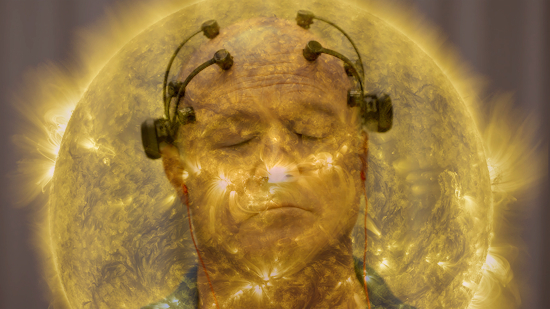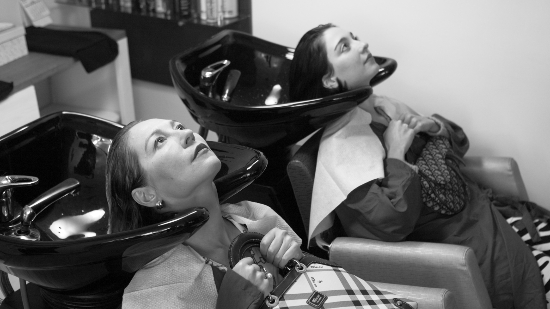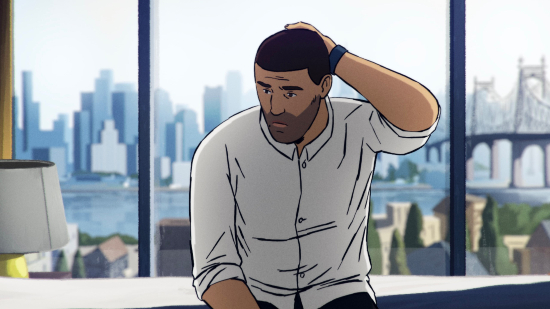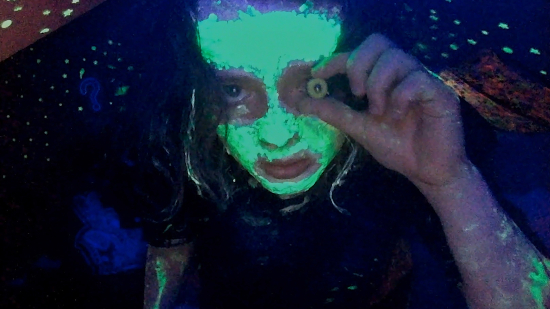
Sundance 2021’s first-ever virtual festival certainly made Festival Director Tabitha Jackson’s first time helming the Park City standby a memorable one. The fest’s adaption to a digital format, streaming its entries around the country from its own online hub, pretty much went off without a hitch—and even had the added benefit of enhancing some of its films (like We’re All Going to the World’s Fair). We couldn’t all gather in the snow, huddle in line together, cram into cramped and overcrowded rentals or get the fest flu after partying and watching some of the best movies on their way to the general public. But we could still share a sense of community and share the conversations sparked by some truly great films. From animation to music docs to dramas and horror of every shape, size and language, Sundance 2021 was filled with thoughtful provocation and unique artistry.
Here are the ten best movies from Sundance 2021, in alphabetical order:
All Light, Everywhere

The camera is a gun according to Theo Anthony, director of All Light, Everywhere, a patchwork documentary which blends interviews, archival footage and even scenes from the film’s cutting room floor in order to dissect the omnipresence of video surveillance—particularly in Black communities which have long been over-policed. Anthony’s filmic medium appears paradoxical considering his vested interest in critiquing the omission of unbiased truth inherent in camera footage—particularly those recorded by police body cams, covert aerial surveillance programs and panopticonic corporate workplaces. But as the director peels back the layers of his methodology, the viewer observes unpolished glimpses of Anthony setting up shots, prepping subjects for interview and divulging research logs—a technique that shatters the illusion of objectivity altogether.
Through obliterating the guise of impartial filmmaking, Anthony examines the insidious history of image capturing as a tool of incarceration and its continued weaponization by the state. It is a self-fulfilling prophecy: Heightened surveillance in minority communities proliferates a high rate of crime—with infinite eyes scanning for crime, more crimes (predominantly minor offenses) are reported and prosecuted. Without the amplification of these invasive practices in affluent white communities, the false narrative of crime-riddled cities—like Anthony’s hometown of Baltimore—is infinitely reinforced. Perhaps the most insidious use of surveillance technology evident in All Light, Everywhere is the intentionally grainy, indeterminate nature of body camera footage itself, the argument being that if the cameras are too perceptive, too unbiased in their ability to document altercations between police and citizens, they might sway courtrooms to see the police’s actions as irresponsible or negligent. After all, if the jury can clearly see that a victim of police brutality was indeed holding a water gun instead of a deadly weapon, how could cops be expected to take accountability for their mistakes? If the premise of authoritarian monitoring isn’t terrifying enough, a scene involving AI-generated faces—composites of would-be individuals (or criminals)—pushes All Light, Everywhere into overt horror. Not just through the uncanny, skin-crawling quality of human non-humans, but by effectively presenting the evil inherent in these technologies when utilized against citizens by corrupt institutions.—Natalia Keogan
Censor

If Peter Strickland’s Berberian Sound Studio and Alexandre Aja’s High Tension had a kid and raised it on Vinegar Syndrome releases, that kid would grow up to be Prano Bailey-Bond’s Censor. A demonstration of refined craftsmanship and a gleeful embrace of horror’s grimiest mores all at the same time, Censor is the ultimate “have cake, eat it too” film, being both exceptionally well-made and stuffed to the gunwales with everything that makes horror worth watching: Creeping dread, paranoia, gross-out violence and inspired fits of madness, with a side of smirking defiance for the conservative pitchfork mobs that have tried to pin all the world’s ills on the genre since always. Bailey-Bond’s film is in conversation with history, the era of Margaret Thatcher and cultural garment-rending over the proliferation of video nasties among impressionable Brits. Enid (Niamh Algar), a film censor, fills her days watching graphically staged dramatizations of brutality, then cutting down their countless offenses to an acceptable size. One such picture too closely resembles a horrible incident from her childhood, one resulting in the disappearance of her sister—or more specifically, it’s the lead actress in the picture who too closely resembles her sister. The encounter sets Enid on a quest to recover her long-lost sibling, which takes her on a descent into insanity…plus a few choice gore shots. But as much as Censor connects with Britain’s past, it connects with horror’s past, too, in keeping with the genre’s tradition of self-awareness and self-critique. When social forces come together to blame horror for the existence of darkness, it’s because those forces can’t stand their own self-reflections. They need an easy way out, and moral panic is easy. Horror knows who the real villains are, and so does Bailey-Bond. Don’t take that as a warning sign, though: Censor isn’t stuffy or preachy, not at all. It’s the reason we go see horror movies in the first place.—Andy Crump

Dash Shaw’s vibrantly animated Cryptozoo explores the oft-fantasized premise of cryptids and humans coexisting, pulling more from Jurassic Park than typical mainstream animated counterparts like Zootopia. Interested in interrogating the exploitation of fantasy and imagination for human consumption, Shaw’s psychedelic, patently adult animated feature brings daydreams into the pointedly violent and bleak reality that its genre contemporaries are privy to ignore. The universe presented in cartoonist/writer/director Shaw’s film—animated in a style that feels like a graphic novel come to life—is our collective memory of the ’60s counterculture movement, but with one key reality-shattering amendment: Every fabled creature from human folklore walks among us, seldom seen but perpetually hunted due to their high demand on the black market. Ceasing the ill-treatment of these creatures is the life’s work of Lauren Gray (Lake Bell), who tracks down abused and injured cryptids and transports them to the Cryptozoo—a live-in amusement park in San Francisco where these beings are put on display or employed, depending on their proximity to human aptitude. While the fantastical idea of cryptids sharing the Earth with existing fauna tantalizes the imagination, the crux of Cryptozoo is bringing this charming premise into our existing hyper-capitalist society—showing just how easily our bloodthirsty system will snuff out the markedly different and extraordinary. Lauren is just one of the film’s many ’60s Bay Area countercultural caricatures—voiced by a litany of alt-comedians and indie movie actors such as Michael Cera, Jason Schwartzman and Zoe Kazan—alongside an idealistic hippie couple that, in one brutal early scene, learn a harsh lesson on imposing simplistic human attitudes on the complex natural world. The film’s critique of capitalism dovetails with its negative view of American countercultural movements, arguing that the commodification of these movements deters them from making any kind of change; the real-world parallels are evident.—Natalia Keogan

The frequently complicated relationship between mother and daughter has fostered plenty of cinematic investigation, but El Planeta easily distinguishes itself as a uniquely meta and universal addition to the canon. The film follows London-based fashion student Leo (Amalia Ulman) upon returning to her rainy hometown of Gijón, Spain, after the death of her father in order to comfort her mother, María (Ale Ulman), whose chronic joblessness leaves debts piling high. In order to stave off eviction and support their solidly middle-class lifestyle, the two begin a series of elaborate ploys to scam and scrape by. Leo poses as the girlfriend of a powerful Spanish politician, awarding her the convenient phrase: “Put that on his tab.” El Planeta finds charm and levity despite the encroaching anxiety of crumbling finances, a fact that has everything to do with the Ulmans’ beautiful on-screen chemistry and the strength of Amalia’s scriptwriting. Humor and misery mingle effortlessly, primarily through evoking the uniquely Spanish tradition of picaresque melodrama, perfectly encapsulated by luxurious fur coats and nonchalant comments of “Thanks, it’s Moschino” as the heat and electricity get shut off. El Planeta is able to remain self-aware where other films have faltered through Ulman’s peppering in her family’s own lived experiences throughout the film. A leg injury Leo sustains, the pair’s financial instability and even the heartache over their dear cat Holga (who is the namesake of Ulman’s production company) are all cemented in fact, allowing for the curtain between fiction and reality to blur in a way that fosters authenticity.—Natalia Keogan
Flee

“Flee.” It’s an imperative, a one-word title telling the audience what a person has to do to save themselves from cultural takeover by barbarians with too many guns: Get the hell out of Dodge. Run for your lives. Flee. Danish documentarian Jonas Poher Rasmussen’s new movie animates the truth of one man, Amin, Rasmussen’s friend, who for the first time in his adult life (and in his relationship with Rasmussen) has decided to open up about the time he and his family cut town when the Taliban took over Kabul. Being an everyday non-fundamentalist person in Afghanistan is hard enough with those lunatics in control. Being both everyday and non-fundamentalist and a closeted young gay man is worse. Sounds real damn grim! It is, of course, and that unavoidable bleakness softens and sharpens through the film’s animated presentation. Using animation to reenact Amin’s perilous journey from Afghanistan to Denmark, with stops along the way in Russia and Estonia, has a way of layering the stunning cruelty Amin endures and observes on the road to safety with an electric playfulness: Even the worst real-life images gain a certain exuberance when recreated by hand. But the film comprises Amin’s recollections, and human memory being what it is—simultaneously faithful, fuzzy, and faulty—the casual alchemical qualities so intrinsic to animation as a medium pull those recollections into harsh relief. Maybe this is the only way Amin can face his past. Animation also has a way of feeling more alive than live-action, or alive in its own separate way, which makes Flee’s darkness all the darker. But Rasmussen isn’t using Amin to make suffering porn. He’s letting Amin tell his story his way. Animation only ultimately acts as a veneer. Even through the layers of artifice, what this movie shows us may be one of cinema’s most harrowing refugee stories.—Andy Crump
Pleasure

Swedish director Ninja Thyberg’s feature debut Pleasure screened in its first iteration at Cannes Critics’ Week in 2014, originally a short film about the shadowy underbelly of the adult film industry. Seven years later, the feature-length project has been fleshed out into an incisive and well-researched film that eviscerates the exploitative practices inherent in male-dominated porn. The film maps out the career trajectory of Bella Cherry (a breakout performance from Sofia Kappel), a Swedish transplant who ventures to L.A. with the goal of ascending to porn stardom. As she rises through the ranks, she finds that her eagerness to succeed and genuine love for the work does not spare her from rampant abuses inherent in the system. The line between consent and coercion is routinely blurred: She is forced to compromise her morals in order to secure more prestigious gigs, the blatant expectation being to push her body to its most painful limits in order to appease the male gaze. Undeniably a critique of the way that culture is perpetually influenced by pornography and vice versa, Pleasure is careful to never veer into anti-sex work rhetoric. One of the most illuminating scenes in the film is when Bella performs on a woman-directed and largely female-staffed porn shoot—a rare instance of the performer achieving orgasm on screen. The film posits that with more women running the show and supporting actors, there would be a marked decrease in harmful male fantasies that often sexualize the abuse of women. In turn, misogynistic attitudes towards women would likely plummet in non-sexual spheres as well.
What’s remarkable about Pleasure is the immersion of the director in the L.A. porn scene, the Swedish citizen traveling back and forth from Europe to the West coast in order to gain the trust of performers and obtain a deeper understanding of an industry she was an ostensible outsider of. Admitting that she originally approached the topic from a completely anti-porn standpoint, Thyberg was eventually converted into a believer of feminist approaches to adult film, realizing that women assuming control of their own sexual proclivities remains a powerful tool for destigmatizing female erotic agency. Pleasure cleverly inverts the male gaze, often focusing on Bella’s face during shoots while lingering on the genitals of male performers and show runners. A wide release would foster a much-needed conversation about porn and the power structures it reinforces, but the inevitable NC-17 rating awaiting the film raises questions as to who might pick it up as a distributor.—Natalia Keogan
Summer of Soul (…Or When the Revolution Could Not Be Televised)

The 1969 Harlem Cultural Festival is the subject of Ahmir Khalib “Questlove” Thompson’s debut documentary feature, Summer of Soul (…Or When the Revolution Could Not Be Televised). More specifically, the documentary examines how this six-week summer festival, which featured many of the most revered Black musicians of all time— including Nina Simone, Stevie Wonder, Sly and the Family Stone and Gladys Knight—went largely unrecognized in America’s cultural consciousness. Featuring an immense catalogue of footage that sat in a basement virtually untouched for 50 years, Summer of Soul acts as an interrogation of what the absence of these materials has meant for the subsequent generation of Black artists, including Questlove himself. Despite the apparent cultural amnesia that followed the event (at least among non-Black Americans), the Harlem Cultural Festival easily overshadowed a ubiquitous moment in American history: The 1969 moon landing. Archival interviews with several attendees reveal that for many Black Americans, the moon landing was not seen as a boundary-pushing event worth celebrating. Catching Stevie Wonder’s set, on the other hand, was. Considering the undeniable essence of colonialism that space travel entails, who can blame them? 300,000 music lovers descended on Mount Morris Park that summer—hardly a negligible amount, especially when compared to Woodstock’s 500,000 attendees. While Woodstock may have been emblematic of the power of counter-culture, the predominance of white spectators in the crowd cemented the event as an artistic awakening. Meanwhile, the equally hyped Harlem Cultural Festival was relegated to the sidelines of historical preservation due to its predominantly Black audience and centering of Black acts on stage.
Summer of Soul was easily one of the most successful films at this year’s Sundance, earning the Grand Jury Prize and Audience Award in the documentary section. But Questlove was never in it for the acclaim, a sentiment made evident in some of the first words the filmmaker uttered during his remote acceptance speech: “I didn’t even know this was a competition, yo!” The documentary was quickly picked up by Searchlight, with a streaming release on Hulu imminent. Whether interested in unraveling an overshadowed cultural event or eager to experience awe-inspiring performances from beloved artists at their best, Summer of Soul surely won’t disappoint.—Natalia Keogan

“Illusion is the first of all pleasures,” says Voltaire, unaware that Argentinian filmmaker Ana Katz would bear out the truth of his poetry a couple centuries after his death. The Dog Who Wouldn’t Be Quiet is a rare, genuine surprise: A small-scale production with grand existential implications. But the film avoids any traces of pomp. It’s quiet, even humble, which feels like a feat given the sobering familiarity audiences will experience during its final 20 minutes. The Dog Who Wouldn’t Be Quiet draws clear inspiration from the COVID-19 pandemic’s world-changing impact, but has the good taste not to bother mirroring its specifics, plus the heart to imagine a world returned to normalcy post-pandemic. Most of all it has a director with enough cinematic economy to condense this string of events into just over an hour’s worth of plot and narrative, and without robbing that string of soul-stirring power. (Katz’s facility with storytelling sleight of hand helps, too.) The Dog Who Wouldn’t Be Quiet follows, over the course of years, young Sebastian (Daniel Katz, Ana’s brother), an illustrator who loses his job on account of bringing his very vocal pooch with him to work, and who then embarks on a journey all around his country picking up any kind of work he can find: Farming, in-home nursing, revolutionary podcasting. Eventually he finds a wife and she makes him a father. All the while he mostly keeps hush, the shine in his eyes and the shy smile lingering at the corners of his lips doing most of his talking for him even when disaster strikes. Talking about The Dog Who Wouldn’t Be Quiet’s specific pieces cannot rob them of their meaning or the film’s indelible shock effect. Katz has made a movie that’s so unique, so new and imaginative, and so casually elliptical that you probably won’t see its many turns and development coming even on a second viewing. Most of all, though, her movie is compassionate, kind and in its own way hopeful, wrapped up with despair in a stunning black-and-white package.—Andy Crump

Brazilian director Iuli Gerbase’s sci-fi-tinged feature debut presents a version of the apocalypse that will be inevitably referenced as an example of “pandemic cinema.” This is chiefly due to the film’s premise of a toxic pink cloud forcing citizens around the globe to hunker down indoors for an indeterminate (and seemingly infinite) period of time, coincidentally mirroring our current COVID crisis. Essentially no more than strangers when the pink cloud appears over their Brazilian city, Giovana (Renata de Lélis) and Yago (Eduardo Mendonça) are compelled to foster a domestic relationship in order to combat the loneliness of being separated from friends and family. As their relationship progresses (or, more aptly, as the cloud-induced quarantine persists), Giovana and Yago begin to discuss their stances on conventional relationship trajectories. A palpable rift appears when Giovana reveals that she does not want to have a child, emphasizing that it would be cruel to raise one in such cramped quarters, never able to experience the beauty of the natural world if the cloud were to endure. It’s impressive (and downright uncanny) that a film written in 2017 and shot in 2019 accurately predicts so many of the specific sensations of living under quarantine: the sudden abundance of elastic waistbands, an immediate dependence on resources being delivered through a monolithic mail-order system, the stray thought of “what will happen to homeless people?” puncturing the bubble of an otherwise mundane conversation. Yet the film captures more than the oppressive boredom and listlessness that an extended quarantine entails, as the cloud itself makes a striking allegory for the imposition of traditional tenets of femininity in conventional heterosexual relationships.—Natalia Keogan
We’re All Going to the World’s Fair

We’re All Going to the World’s Fair isn’t straightforwardly a “horror” movie—even if the title reads like an invocation chanted by hypnotized cultists doomed to whatever fate awaits them at the fairgrounds. That, of course, is more or less exactly what it is, as evinced in the opening sequence, where young Casey (Anna Cobb) recites the phrase three times while staring wide-eyed at her computer monitor. Innocent enough, if firmly eerie. Then she pricks her finger with a button’s pin about two dozen times in rapid succession and streaks her blood on the screen (though just out of the audience’s line of sight) to conclude the ritual. All that’s left is to wait and see how joining in this online “game” changes her, as if undergoing a Cronenbergian rite of passage. What writer/director Jane Schoenbrun wants viewers to wonder is whether those changes are in earnest, and whether changes documented by other participants in the “World’s Fair challenge” are legit or staged. They’re unreliable narrators. To an extent, so is Casey—insomuch as teens stepping into the world solo for the first time can be relied on for anything resembling objectivity. There’s also the question of exactly where Casey draws the line between truth and macabre make-believe, and of course whether that belief is made up. Maybe there really is a ghost in the machine. Or maybe a life predominantly lived in a virtual space—because physical space is dominated by isolation and bad paternal relationships—naturally inclines people toward delusion at worst and an unerring sensation of disembodiment at best. We’re All Going to the World’s Fair concludes with ambiguity and atmospheric loss, as if we’re meant to consider leaving childhood behind as a form of tragedy. Spoken in Schoenbrun’s language, that process is painful, transformative and—first and foremost—an internal experience regardless of the movie’s stripped-down visual pleasures. Outside forces influence Casey, but Casey ultimately controls the direction those forces take her. In a way, that’s empowering. But Schoenbrun belies the collective dynamic implied in We’re All Going to the World’s Fair’s title with Casey’s lonesome reality.—Andy Crump